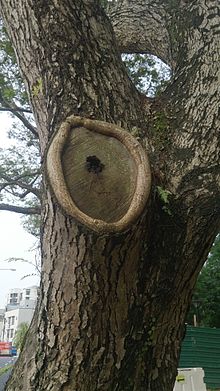| Branch Collar | |
|---|---|
 | |
| Organisms | Woody Plants |
| Biological system | Plant Structural Member |
| Health | Beneficial |
| Action | Involuntary |
A branch collar is the "shoulder" between the branch and trunk of woody plants; the inflammation formed at the base of the branch is caused by annually overlapping trunk tissue.[1] The shape of the branch collar is due to two separate growth patterns, initially the branch grows basipetally, followed by seasonal trunk growth which envelops the branch.[1]
Branch collars serve as a strong foundation to the branch, and its orientation and internal characteristics allow the branch to withstand stress from numerous directions.[2] Functionally the branch collars also influence the conductivity of nutrients and growth patterns.[3][4]
The branch collar which provides a protective barrier to prevent infection and decay, can also be useful in diagnosing bacterial diseases.[1][5]
Proper pruning techniques should accommodate for the branch collar structure, as by damaging the tree it is likely to decay or become diseased.[1]
- ^ a b c d Shigo, Alex L. (1985). "How tree branches are attached to trunks". Canadian Journal of Botany. 63 (8): 1391–1401. doi:10.1139/b85-193.
- ^ Müller, Ulrich; Gindl, Wolfgang; Jeronimidis, George (2006-09-01). "Biomechanics of a branch – stem junction in softwood". Trees. 20 (5): 643–648. Bibcode:2006Trees..20..643M. doi:10.1007/s00468-006-0079-x. ISSN 1432-2285. S2CID 25258398.
- ^ Eisner, Nathan; Gilman, Edward; Grabosky, Jason (2002). "Branch Morphology Impacts Compartmentalization of Pruning Wounds" (PDF). Journal of Arboriculture. 28 (2): 99–105. doi:10.48044/jauf.2002.013. S2CID 246537796.
- ^ Gardiner, Barry; Quine, Christopher. "The mechanical adaption of tree to environmental influences". Proceedings of 3rd Plant Biomechanics Conference: 71–82 – via Research Gate.
- ^ Nakanishi, Yoshihiro; Takesaki, Ken; Miyaji, Katsuhiko; Kitazawa, Hiroaki (2016-09-01). "Detection of Candidatus Liberibacter asiaticus from branch collars of citrus trees". Journal of General Plant Pathology. 82 (5): 248–253. Bibcode:2016JGPP...82..248N. doi:10.1007/s10327-016-0666-7. ISSN 1610-739X. S2CID 18809076.